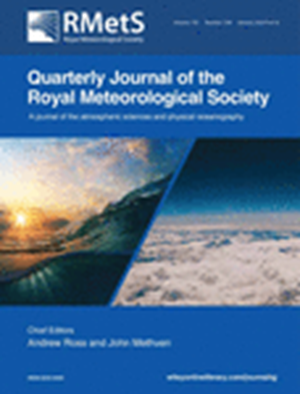根据时变海水密度生成随状态变化的集合扰动,用于 GloSea5 初始化
IF 2.9
3区 地球科学
Q2 METEOROLOGY & ATMOSPHERIC SCIENCES
引用次数: 0
摘要
在这项研究中,我们开发了一种取决于流量的海洋初始化系统,用于初始化全球季节预报系统第 5 版(GloSea5)中的海洋温度和盐度。我们的算法克服了集合优化插值(EnOI)中静态扰动的限制,沿等比线传播观测信息,创建三维快照密度状态。我们将所提出的算法称为基于状态依赖的集合最优插值(SD-EnOI),它考虑了背景误差协方差随时间的变化,而无需依赖集合模型模拟。为了评估SD-EnOI生成的海洋初始条件(IC)的质量,我们将其与韩国气象厅(KMA)在2017年1月至2017年12月期间运行的全球海洋数据同化和预测系统版本1(GODAPS1)生成的IC进行了比较。我们的研究结果表明,SD-EnOI集成电路的热构造比GODAPS1更真实,尤其是在热带太平洋地区。在 GODAPS1 集成电路中观测到的海面温度(SST)的强烈暖偏差和浅混合层深度偏差在 SD-EnOI 中没有显示。由于SD-EnOI集成电路中的海洋热结构更加逼真,与使用GODAPS1集成电路相比,在回顾性预报试验中使用SD-EnOI集成电路,可以系统地减少在预报长达4个先导月时太平洋中东部的气候学SST漂移。这表明初始化过程对动态季节预报质量的影响很大。本文章由计算机程序翻译,如有差异,请以英文原文为准。
Generation of state‐dependent ensemble perturbations based on time‐varying seawater density for GloSea5 initialization
In this study, we developed a flow‐dependent oceanic initialization system for initializing the oceanic temperature and salinity in the Global Seasonal forecast system version 5 (GloSea5). Our algorithm overcomes the limitation of stationary perturbations for Ensemble Optimal Interpolation (EnOI) by spreading observed information along isopycnal lines to create three‐dimensional snapshot density states. The proposed algorithm, which we call state‐dependent ensemble‐based EnOI (SD‐EnOI), takes into account changes in the background error covariance over time without relying on ensemble model simulations. To evaluate the quality of the oceanic initial conditions (ICs) produced by SD‐EnOI, we compared them with those generated by the Global Ocean Data Assimilation and Prediction System version 1 (GODAPS1) operated by the Korea Meteorological Agency (KMA) throughout January 2017 to December 2017. Our findings show that the thermal construction of the SD‐EnOI ICs is more realistic than that of GODAPS1, particularly in the tropical Pacific region. The strong warm bias in sea surface temperature (SST) and the shallow mixed‐layer depth bias observed in the GODAPS1 ICs are not shown in SD‐EnOI. Due to the more realistic oceanic thermal structure present in the SD‐EnOI ICs, their use in retrospective forecast experiments resulted in a systematic reduction in climatological SST drift in the central‐eastern Pacific for forecasts up to four lead months compared to using GODAPS1 ICs. This demonstrates the significant impact of the initialization process on the quality of dynamical seasonal forecasts.
求助全文
通过发布文献求助,成功后即可免费获取论文全文。
去求助
来源期刊
CiteScore
16.80
自引率
4.50%
发文量
163
审稿时长
3-8 weeks
期刊介绍:
The Quarterly Journal of the Royal Meteorological Society is a journal published by the Royal Meteorological Society. It aims to communicate and document new research in the atmospheric sciences and related fields. The journal is considered one of the leading publications in meteorology worldwide. It accepts articles, comprehensive review articles, and comments on published papers. It is published eight times a year, with additional special issues.
The Quarterly Journal has a wide readership of scientists in the atmospheric and related fields. It is indexed and abstracted in various databases, including Advanced Polymers Abstracts, Agricultural Engineering Abstracts, CAB Abstracts, CABDirect, COMPENDEX, CSA Civil Engineering Abstracts, Earthquake Engineering Abstracts, Engineered Materials Abstracts, Science Citation Index, SCOPUS, Web of Science, and more.

 求助内容:
求助内容: 应助结果提醒方式:
应助结果提醒方式:


